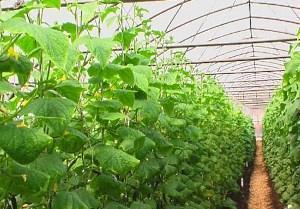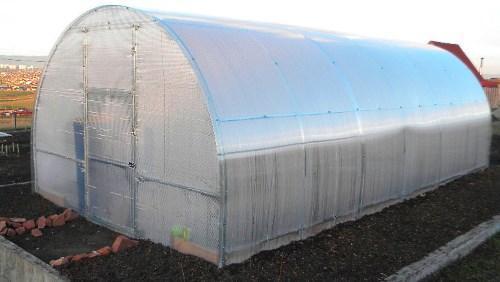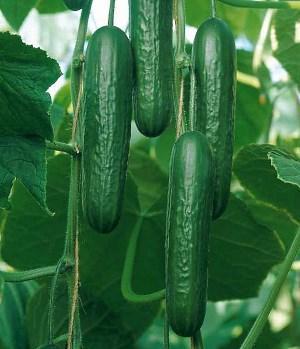Year-round cultivation of cucumbers in a greenhouse
 Fresh crispy cucumbers from your own garden in winter is not a fantasy. Growing cucumbers in greenhouses is possible all year round, even in unfavorable climatic conditions. The technology and rules for growing cucumbers in greenhouses include ensuring temperature and lighting, watering, feeding, pest and disease control.
Fresh crispy cucumbers from your own garden in winter is not a fantasy. Growing cucumbers in greenhouses is possible all year round, even in unfavorable climatic conditions. The technology and rules for growing cucumbers in greenhouses include ensuring temperature and lighting, watering, feeding, pest and disease control.
Greenhouse equipment
A greenhouse on a personal plot is installed in such a way that it is not exposed to the north wind. The site should be flat or slightly sloped to the south. If there is no wind protection, then a fence is installed on the north side. It is necessary to take care of the irrigation scheme in advance. The volume to area ratio should be 2: 1. This is the optimal parameter for maintaining the internal temperature regime. Greenhouses use plastic wrap as a protective surface. It can be mounted on slopes 15-20 degrees.

Soil preparation
In the cold season, the cultivation of cucumbers in the greenhouse is carried out on "warm" beds: manure or compost:
- For the device of a manure bed, fresh cow is taken manureslightly diluted with horse. It performs two functions at once: feeding and heating. The manure is placed in the garden bed. A layer of fertile soil 20-25 cm high is poured onto it. The bed is watered abundantly with water. The seeds can be planted without first germinating. The garden bed is covered with plastic wrap. Seedlings will appear in a few days. During the decomposition process, manure generates a large amount of heat. This promotes the growth of the cucumbers, but care must be taken not to overheat. Even at low external values, the temperature under the film rises above 30 ° C, reaching peaks when exposed to direct sunlight. The abundant generation of heat by manure lasts about a month. Then the temperature gradually drops. This must be taken into account when calculating the landing dates.
- How to grow cucumbers in a greenhouse if it is problematic to get fresh manure? They resort to the second method of arranging a "warm bed" - compost. Organic waste is used as compost: sawdust, shavings, foliage, tops. The fresher the organic matter, the higher the temperature released. If possible, add manure and special chemical compounds that accelerate the decomposition process. The layout of the beds is similar to that of manure, but it is better to plant the seeds already germinated in peat cups. The release of heat energy on compost beds is not as intense as on manure beds. This method is more suitable for warm regions.
Choosing cucumber seeds for the greenhouse
 Greenhouse cucumber varieties differ from those adapted for outdoor cultivation... Those are chosen that tolerate low light well. The second important issue is pollination. In summer, bees, bumblebees and other flying insects do well with it in open beds. And in the cold season, they have nowhere to take. Plants can be manually pollinated, but the process is laborious.
Greenhouse cucumber varieties differ from those adapted for outdoor cultivation... Those are chosen that tolerate low light well. The second important issue is pollination. In summer, bees, bumblebees and other flying insects do well with it in open beds. And in the cold season, they have nowhere to take. Plants can be manually pollinated, but the process is laborious.
The best choice is self-pollinated cucumber seeds for greenhouses:
- Malachite;
- Stella;
- Turquoise;
- Lada.
These are long-fruited hybrids. They tolerate lack of light well and are suitable for early planting.
Special greenhouse varieties of cucumbers were developed for cultivation in Siberia and central Russia. It:
- Buyan;
- Ant;
- Murashko;
- Bidrett;
- Twixie;
- Halley.
For spring planting are popular:
- Elegant;
- VIR 516;
- Altai early 166.
The varieties are distinguished by high resistance to lack of light and moisture:
- Marfinsky;
- Russian;
- Home;
- Relay race;
- Rykovsky;
- Regatta;
- Willow;
- NK-mini.
The best varieties of cucumbers for greenhouses are also considered to be Gribovsky 2 and Maisky. They bear fruit 50 days after seed germination.
The best germination is 2-3 year old seeds. Before planting, they are calibrated by removing empty and sick ones. To disinfect seeds, an aqueous solution is prepared from boric acid, copper sulfate and nitrophoska. Aloe juice is also suitable for this purpose. The seeds are spread on a cloth moistened with a solution and kept for 12 hours. After that, they are washed under running water, laid out on wet gauze and placed in a refrigerator for a week for hardening. Quenching temperature - 0 ° С. The gauze is periodically moistened.
Rules for caring for cucumbers in a greenhouse
In greenhouses, the seedling method of planting cucumbers is more often used. He gives earlier harvests. Before planting cucumbers in a greenhouse on a garden bed, they are grown in small pots (plastic cups are suitable). The seeds are deepened by 2 cm, and the glass is covered with a damp cloth on top so that the soil does not dry out. Until the sprouts appear, the temperature is maintained at +25 ° C. after the shoots appear, the temperature is reduced for 5 days to + 15 ° С during the day and +12 ° С at night. Watered seedlings every other day and periodically fed with a solution of cow manure in proportions of 1: 6.
Planting on the beds is done 25 days after the emergence of shoots. Planting scheme: two-line tape 50x20 cm. The distance between the beds is 80 cm. The temperature regime for growing cucumbers in the greenhouse is maintained within + 25-30 ° С during the day and +15 ° С at night.
The first feeding of plants is carried out with the appearance of the third true leaf, the second - at the beginning of flowering. During fruiting fertilizers entered up to 4 times. In addition to cow or bird manure, sandy soils need nitrogen fertilizers, and floodplains - in potash.
Before flowering, watering is done every 5 days, then every 2 days. However, if the leaves turn yellow, the rate must be increased. Use warm water for irrigation.
After each watering, shallow loosening of the soil is carried out. It is necessary for air access to the roots and prevent them from rotting. The greenhouse needs regular ventilation. As it warms, it should be open all day and closed at night.
For garters of cucumbers, trellises are installed. A wire is stretched along each row at a height of 2 m. Twine is attached to it above each plant. Plants are tied up at a height of 10-15 cm from the ground. The loop should be loose enough to accommodate the thickening of the stem. Too tight a garter will cut into the stem and weaken the plant's nutrition.
As the bush grows, it should be shaped. Lateral lashes grow and shade the plant, and the root system and stem do not provide adequate nutrition for the fruit. This reduces yields. The lower processes are pinched after the formation of the first leaf, the higher ones - at the level of 2-3 leaves.

Winter cucumbers
If in the spring the plastic film is able to provide the temperature regime, then the cultivation of cucumbers in the winter in the greenhouse is impossible without additional artificial heating. Ovens and heaters of various types are used, but it should be borne in mind that they dry out the air, and this negatively affects moisture-loving cucumbers. For moistening, containers with water are placed throughout the greenhouse, and the plants are regularly sprayed with a spray bottle.
Even the most persistent varieties lack lighting in winter. The recommended rate of artificial lighting is 400 W / m2. Before the shoots appear, continuous illumination is carried out for 2-3 days. Above only germinated seedlings, lamps are installed at a height of 50-60 cm and illuminate them for 14 hours a day.Before planting seedlings in the ground, the lighting is turned off for one day. As the plants grow, the lamps are raised to a height of 1.5 m. Good lighting has a beneficial effect on the content of sugars and ascorbic acid in fruits.
To obtain a harvest in December-January, the seeds are sown at the end of September, and the seedlings are transplanted to the beds at the end of October. The collection of the earliest cucumbers in the greenhouse continues until April.
Diseases and pests
 Disease is a major problem in greenhouse cucumber cultivation. The most common are powdery mildew and peronosporos:
Disease is a major problem in greenhouse cucumber cultivation. The most common are powdery mildew and peronosporos:
1. Powdery mildew most often attacks plants during warming. This disease is dangerous and can kill cucumbers in a few days. It appears as a powdery coating on the leaves. They quickly turn yellow and dry out. To combat the disease, potassium permanganate, sulfaride, Impact 25%, Quadris 250 SC are used. In sunny warm weather, cucumbers are processed with ground sulfur.
2. Peronosporos appears as yellow or green oily spots on the leaves, which gradually darken, acquiring a brown tint. When a disease is detected, watering and feeding are stopped. For treatment, solutions of copper oxychloride or polycarbacin are used. Spraying with systemic fungicides is also effective. It is recommended to ventilate the greenhouse after processing. In case of peronosporosis, it is important to maintain daytime temperatures in the greenhouse not lower than +20 ° С, night temperatures not lower than +18 ° С.
The main pests of cucumbers are aphids, mites, thrips, wireworms. Chemicals are used against them: Confidor, Bi-58, Decis-Duplet and others.